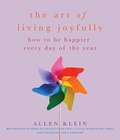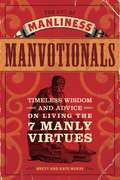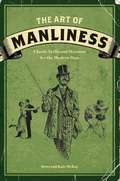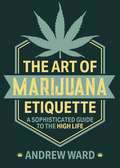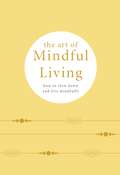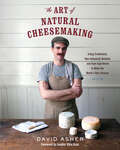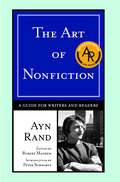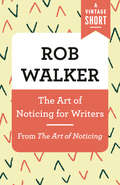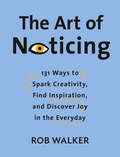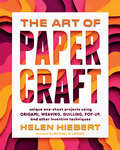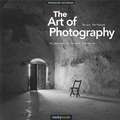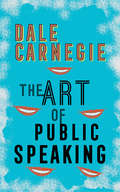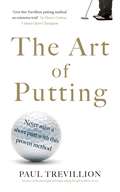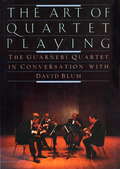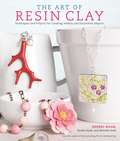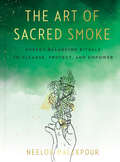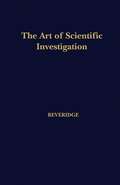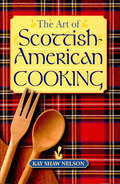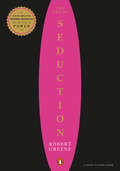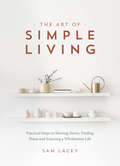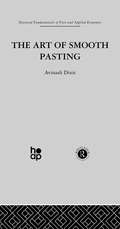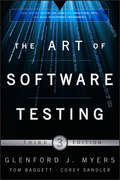- Table View
- List View
The Art of Living Joyfully
by Sark Allen KleinAllen Klein is a motivational speaker and author who believes strongly in the way words can influence how we feel mentally, physically, and spiritually. In this day of tweeting, texting, cyberspeak and the non-language of E-mail, the written and spoken word has the power to touch our hearts and lift our spirit that is extraordinary.In this The Art of Living Joyfully, Jollytologist Allen Klein presents a compendium of advice and plain common sense comprising a guide to good cheer. This wonderful collection of quips, quotes and instruction comes from a variety of people and from all eras of history. Dividing the books thematically, covering such topics as Friendship, Laughter, Beauty, Nature, Faith, and more, this is a book to cherish for oneself and to give as a heartfelt gift.HENRY DAVID THOREAU on Friendship: "The most I can for my friend is simply to be his friend,"WILLIAM SHAKESPEARE on Laughter: "A light heart lives long."RALPH WALDO EMERSON on Happiness: "Happiness is a perfume which you cannot pour on someone without getting some on yourself."SOPHOCLES on Love: "One word frees us of all the weight and pain of life: That word is love."MARTIN LUTHER on Nature: "Our Lord has written the promise of resurrection, not in books alone but in every leaf of springtime."From yesteryear to yesterday to today; from the famous to the little known; on subjects that touch our lives every day in every way, the selection of quotes in THE ART OF LIVING JOYFULLY offers insight and inspiration to help you and those you care about feel good about themselves and life.
The Art of Manliness - Manvotionals: Timeless Wisdom and Advice on Living the 7 Manly Virtues
by Brett McKay Kate McKayWhat Makes a Man, a Man?For centuries, being a man meant living a life of virtue and excellence. But then, through time, the art of manliness was lost.Now, after decades of excess and aimless drift, men are looking for something to help them live an authentic, manly life--a primer that can give their life real direction and purpose.This book holds the answers. To master the art of manliness, a man must live the seven manly virtues: Manliness, Courage, Industry, Resolution, Self-Reliance, Discipline, Honor.Each chapter covers one of the seven virtues and is packed with the best classic advice ever written down for men. From the philosophy of Aristotle to the speeches and essays of Theodore Roosevelt, these pages contain the manly wisdom of the ages--poems, quotes, and essays that will inspire you to live life to the fullest and realize your complete potential.Learn the art. Change your life. Become a man.
The Art of Manliness: Classic Skills and Manners for the Modern Man
by Brett MckayMan Up!While it's definitely more than just monster trucks, grilling and six-pack abs, true manliness is hard to define. The words macho and manly are not synonymous.Taking lessons from classic gentlemen such as Benjamin Franklin and Theodore Roosevelt, authors Brett and Kate McKay have created a collection of the most useful advice every man needs to know to live life to its full potential.This book contains a wealth of information that ranges from survival skills to social skills to advice on how to improve your character. Whether you are braving the wilds with your friends, courting your girlfriend or raising a family, inside you'll find practical information and inspiration for every area of life. You'll learn the basics all modern men should know, including how to:Shave like your grandpaBe a perfect houseguestFight like a gentleman using the art of bartitsuHelp a friend with a problemGive a man hugPerform a fireman's carryAsk for a woman's hand in marriageRaise resilient kidsPredict the weather like a frontiersmanStart a fire without matchesGive a dynamic speechLive a well-balanced lifeSo jump in today and gain the skills and knowledge you need to be a real man in the 21st century.
The Art of Marijuana Etiquette: A Sophisticated Guide to the High Life
by Andrew WardHere is the first, proper guide on etiquette for those using cannabis for recreation and medicinal purposes. Written by a seasoned journalist, both novices and seasoned tokers can now partake without annoying or offending anyone. When it comes to cannabis, there are numerous unspoken rules that users take very seriously. Whether we're talking about puff, puff, pass or supplying your own munchies, the marijuana community has always tried to keep etiquette as a staple of the lifestyle. Now, from one stoner to another, The Art of Marijuana Etiquette will guide you through all phases of weed life so you can enjoy the highest quality hydroponic without being disrespectful to those around you. Some key lessons include: Understanding the language and terminologyStep-by-step details on how to rollTips and tricks to improve your smoking sessionHow to prepare for a visit to legal dispensariesAnd much more. As the negative connotation of marijuana begins to dissipate, there will be more people partaking than ever. That's why noted journalist Andrew Ward has sat down with those in the marijuana community to find out what they find the most important lessons to share, so that veteran and amateur smokers can get the most out of this incredible plant. Having this handy guide to teach you in the ways of weed will make sure that you can continue the proud tradition of respect among stoners, while also educating those joining the party on how to carry themselves. Respect is key, and the more you understand about how to enjoy and medicate with cannabis, the better we will all be.
The Art of Mindful Living: How to Slow Down and Live Mindfully
by Octopus BooksMindful is about fully appreciating life's little pleasures and the most precious of moments that, all too often, pass by unnoticed when the mind is distracted.Though it seems like a paradox, slowing down to focus on one thing at a time and resisting the urge to multi-task can actually make us more productive by allowing us to deliberately concentrate our energy on our most important tasks. Likewise, mindful living also helps us be more aware of our thought patterns so that we can cultivate inner peace and appreciate the beauty in our day to day lives.This little collection of tips, inspirational quotes and reflections will help you find new strategies to:- stay focused and resist the urge to multitask,- take a few minutes to meditate and recentre yourself,- create a calming environment,- appreciate the beauty around you,- be more patient,- and manage your emotions to cultivate inner peace.This book will show you just how impactful it can be to take a few short moments to calm your mind and will ultimately help live a more peaceful and focused life.
The Art of Mindful Living: How to Slow Down and Live Mindfully
by PyramidMindful is about fully appreciating life's little pleasures and the most precious of moments that, all too often, pass by unnoticed when the mind is distracted. Though it seems like a paradox, slowing down to focus on one thing at a time and resisting the urge to multi-task can actually make us more productive by allowing us to deliberately concentrate our energy on our most important tasks. Likewise, mindful living also helps us be more aware of our thought patterns so that we can cultivate inner peace and appreciate the beauty in our day to day lives.This little collection of tips, inspirational quotes and reflections will help you find new strategies to:- stay focused and resist the urge to multitask,- take a few minutes to meditate and recentre yourself,- create a calming environment,- appreciate the beauty around you,- be more patient,- and manage your emotions to cultivate inner peace.This book will show you just how impactful it can be to take a few short moments to calm your mind and will ultimately help live a more peaceful and focused life.
The Art of Natural Cheesemaking: Using Traditional, Non-Industrial Methods and Raw Ingredients to Make the World's Best Cheeses
by David AsherIncluding more than 35 step-by-step recipes from the Black Sheep School of CheesemakingMost DIY cheesemaking books are hard to follow, complicated, and confusing, and call for the use of packaged freeze-dried cultures, chemical additives, and expensive cheesemaking equipment. For though bread baking has its sourdough, brewing its lambic ales, and pickling its wild fermentation, standard Western cheesemaking practice today is decidedly unnatural. In The Art of Natural Cheesemaking, David Asher practices and preaches a traditional, but increasingly countercultural, way of making cheese—one that is natural and intuitive, grounded in ecological principles and biological science.This book encourages home and small-scale commercial cheesemakers to take a different approach by showing them:• How to source good milk, including raw milk;• How to keep their own bacterial starter cultures and fungal ripening cultures;• How make their own rennet—and how to make good cheese without it;• How to avoid the use of plastic equipment and chemical additives; and• How to use appropriate technologies.Introductory chapters explore and explain the basic elements of cheese: milk, cultures, rennet, salt, tools, and the cheese cave. The fourteen chapters that follow each examine a particular class of cheese, from kefir and paneer to washed-rind and alpine styles, offering specific recipes and handling advice. The techniques presented are direct and thorough, fully illustrated with hand-drawn diagrams and triptych photos that show the transformation of cheeses in a comparative and dynamic fashion.The Art of Natural Cheesemaking is the first cheesemaking book to take a political stance against Big Dairy and to criticize both standard industrial and artisanal cheesemaking practices. It promotes the use of ethical animal rennet and protests the use of laboratory-grown freeze-dried cultures. It also explores how GMO technology is creeping into our cheese and the steps we can take to stop it.This book sounds a clarion call to cheesemakers to adopt more natural, sustainable practices. It may well change the way we look at cheese, and how we make it ourselves.
The Art of Nonfiction
by Ayn RandRand's lectures take listeners step by step through the writing process. From preparing an outline to polishing a draft to mastering an individual writing style, this crucial resource introduces the ideas of one of our most enduring authors to a new generation.
The Art of Nonfiction: A Guide for Writers and Readers
by Ayn Rand Peter SchwartzA remarkable series of lectures on the art of creating effective nonfiction by one of the 20th century's most profound writers and thinkers--now available for the first time in print.Culled from sixteen informal lectures Ayn Rand delivered to a select audience in the late 1960s, this remarkable work offers indispensable guidance to the aspiring writer of nonfiction while providing readers with a fascinating discourse on art and creation. Based on the concept that the ability to create quality nonfiction is a skill that can be learned like any other, The Art of Nonfiction takes readers through the writing process, step-by-step, providing insightful observations and invaluable techniques along the way. In these edited transcripts, Rand discusses the psychological aspects of writing, and the different roles played by the conscious and unconscious minds. From choosing a subject to polishing a draft to mastering an individual writing style--for authors of theoretical works or those leaning toward journalistic reporting--this crucial resource introduces the words and ideas of one of our most enduring authors to a new generation.
The Art of Noticing for Writers: From The Art of Noticing (A Vintage Short)
by Rob WalkerA Vintage Shorts selection.Becoming a first-class noticer is crucial to any creative process, but perhaps it is particularly crucial for a writer. In the era of white noise, when the ability to be present is often lost, Rob Walker’s provocations and exercises will enchant and delight, and help writers of all stripes develop an original point of view. Drawn from his gorgeous illustrated volume, The Art of Noticing, twenty selections ranging in scope from “Hunt for a feeling” to “Detect imaginary clues” make for an enjoyable cure for writer’s block, and a resource that writers of all walks of life will treasure and come to for inspiration again, and again. An ebook short.
The Art of Noticing: 131 Ways to Spark Creativity, Find Inspiration, and Discover Joy in the Everyday
by Rob WalkerAn imaginative, thought-provoking gift book to awaken your senses and attune them to the things that matter in your life.Welcome to the era of white noise. Our lives are in constant tether to phones, to email, and to social media. In this age of distraction, the ability to experience and be present is often lost: to think and to see and to listen.Enter Rob Walker's The Art of Noticing. This gorgeously illustrated volume will spark your creativity--and most importantly, help you see the world anew. Through a series of simple and playful exercises--131 of them--Walker maps ways for you to become a clearer thinker, a better listener, a more creative workplace colleague and finally, to rediscover your sense of passion and to notice what really matters to you.
The Art of Papercraft: Unique One-Sheet Projects Using Origami, Weaving, Quilling, Pop-Up, and Other Inventive Techniques
by Helen HiebertPaper artist and teacher Helen Hiebert compiles a one-of-kind collection of 40 unique projects, each using just one sheet of paper. Combining decorative paper techniques like marbling, stamping, and stenciling with dimensional techniques like origami, cutting, folding, quilling, stretching, weaving, and pop-ups, The Art of Papercraft offers a rich variety of projects that will delight crafters, artists, and designers alike, including paper votive lights, pop-up cards, folded paper gift boxes and envelopes, woven paper wall hangings, miniature one-sheet books, and much more. Every project is beautifully photographed and accompanied by step-by-step visual instructions. Guidance on selecting tools, materials, and paper selection; in-depth technique instructions; and profiles of contributing paper artists make this a rich and practical celebration of papercraft. This publication conforms to the EPUB Accessibility specification at WCAG 2.0 Level AA.
The Art of Photography
by Bruce BarnbaumThis is a newly revised edition of the classic book The Art of Photography (first published in 1994), which has often been described as the most readable, understandable, and comprehensive textbook on photography. In his accessible style, Barnbaum presents how-to techniques for both traditional and digital approaches. Yet he goes well beyond the technical as he delves deeply into the philosophical, expressive, and creative aspects of photography. This book is geared toward every level of photographer who seeks to make a personal statement through their chosen medium. Bruce Barnbaum is recognized as one of the world's finest photographers as well as an elite instructor. This newest incarnation of his book, which has evolved over the past 35 years, will prove to be an invaluable photographic reference for years to come. This is truly the resource of choice for the thinking photographer. Filled with over 100 beautiful photographs, as well as numerous charts, graphs, and tables. of photography. This latest incarnation of his textbook, which has evolved, grown, and been refined over the past 35 years, will prove to be an ongoing, invaluable photographic reference for years to come. It is truly the resource of choice for the thinking photographer.
The Art of Public Speaking
by Dale CarnegieA pioneer in the field of self-help, Dale Carnegie distilled his experiences as a salesman and lecturer in this first guide to successful speech-making. The Art of Public Speaking is direct, practical advice for emphasizing ideas for easy comprehension and high impact ranges from finding an appropriate rhythm to conquering stage fright.Avoiding the use of tricks and shortcuts, the author suggests methods for developing one's thoughts in order to form an original, authentic manner of speaking. He advises speakers to practice their presentation skills, offering useful tips for speech-making in both personal and professional situations. First published in 1915, this classic continues to encourage people from all walks of life to overcome their self-consciousness and increase their effectiveness and comfort as public speakers.Penguin Random House Canada is proud to bring you classic works of literature in e-book form, with the highest quality production values. Find more today and rediscover books you never knew you loved.
The Art of Putting: Trevillion's Method of Perfect Putting
by Paul TrevillionLearn to putt . . . perfectly 'How to never miss a 4ft putt . . . ever. The perfect putting method' GQ Magazine________________Learn how to master the Trevillion Pencil Grip - the foolproof method that has been adopted by the professionals themselves: Fleetwood, Rose, Garcia, Francesco Molinari and Branden Grace are just a few . . . Championships are won and lost on the putting green, and one of the most repeated phrases after a disappointing round of golf is 'If only I'd holed my putts'. But there is a simple way to dramatically improve your 'pressure putt' performance: The Trevillion Pencil Grip.Renowned sports artist Paul Trevillion is the inventor of the uniquely effective split-hand technique. He describes the pencil grip, which he spent four decades refining, as the 'art' of putting: you aim at the hole and draw a straight line. As he explains: 'Too often on TV you hear, "he pushed the putt"... but an artist never pushes a pencil.'In The Art of Putting, Paul Trevillion discusses the evolution of putting methods and reveals the secret of his technique with honesty and humour. Instructive, entertaining, practical, unique and effective, this book is one of the soundest investments any golfer can make to ensure that they never miss a four-foot putt.'I am so confident in my putter and method that I challenged the top 50 golfers in the world to a $1000,000.00 putting challenge' Paul Trevillion'Very few titles are won by golfers who putt badly, no matter how supreme a player's ball striking is, such prowess will always be undone by a missed three-footer . . . putting is an art rather than a science' BBC SPORT
The Art of Quartet Playing: The Guarneri Quartet in Conversation with David Blum
by David BlumHow do four instrumentalists with strong individual tastes and temperaments manage to forge a distinctive approach to the music they play? This extraordinary book ushers readers into the workshop of one of the world's most accomplished string quartets. In rich and probing conversations with their longtime friend and musicologist and conductor David Blum, the members of the Guarneri String Quartet, both individually as a group, tell what it is like to play together.
The Art of Resin Clay: Techniques and Projects for Creating Jewelry and Decorative Objects
by Rachel Haab Sherri Haab Michelle HaabDiscover the Creative Possibilities of Resin Clay Imagine being able to imitate the look of rare coral, create oversized but featherweight statement jewelry, or mix clay with other mediums--all without firing. The Art of Resin Clay explores the creative potential of this material, in both air-dry and two-part formulas, and guides you through everything you'll need to get started: * Information on choosing the right kind of resin clay, essential tools and techniques, and safety guidelines* Tips for mixing colors, finishing, and adding jewelry findings* 20 projects covering a variety of creative techniques * Galleries of work by influential artists and crafts designers who use this versatile materialFrom the Trade Paperback edition.
The Art of Sacred Smoke: Energy-Balancing Rituals to Cleanse, Protect, and Empower
by Neelou MalekpourA gorgeously illustrated, essential guide to the energy rituals that will transform your life.Learn how to cleanse and protect yourself and your space, tap into your intuition, and elevate your frequency through sacred smoke, candle, stone rituals—and more. Neelou Malekpour is here to support you for all occasions, whether that&’s: • healing heartache, relieving anxiety, and dispelling bad dreams; • cultivating focus, receiving support during travel, and prepping a space for meditation; or • calling in love, blessing others, and connecting to your highest self. With The Art of Sacred Smoke, Malekpour is ready to share the rituals that are essential to aligning and calibrating your energy. Learn how to use the natural ingredients she employs in her practices—and in her frequency-raising business, SMUDGED—from rose petals to palo santo, and how to source them responsibly. At a time when many of us are looking for mindful solutions to the chaos of modern life, The Art of Sacred Smoke offers an empowering new way to connect to nature and to your best self.
The Art of Scientific Investigation
by William I.B. BeveridgeIn The Art of Scientific Investigation, originally published in 1950, W.I.B. Beveridge explores the development of the intuitive side in scientists. The author's object is to show how the minds of humans can best be harnessed to the processes of scientific discovery. This book therefore centers on the "human factor"; the individual scientist. The book reveals the basic principles and mental techniques that are common to most types of investigation. Professor Beveridge discusses great discoveries and quotes the experiences of numerous scientists.
The Art of Scottish-American Cooking
by Kay Shaw NelsonThis history, travelogue and cookbook contains over two hundred recipes celebrating four centuries of Scottish cultural and culinary legacy in America. In this comprehensive cookbook, learn about the glories of shortbread, or Scotch cake, a unique Scottish creation, as well as marvelous rock buns and Dundee cake. Find out how the Scots introduced fried chicken to America and enjoy recipes for happit hen, wet devil, and Scotch grouse. Digest the histories of the Campbell Soup company, Old Crow Bourbon whiskey, and the graham cracker, invented by the eccentric clergyman Sylvester Graham. Try your hand at innovative egg dishes, fish pies, Scottish hot dogs, oatcakes, scones, griddle breads, and crumpets. Finally, make an ale toast at Hogmanay (New Year&’s Eve) and ring in the New Year celebrating the many Scottish American contributions to our daily lives. Scottish-American author Kay Shaw Nelson has combined her ancestral pride, her travel experiences and love of gastronomy to create The Art of Scottish-American Cooking, an homage to four hundred years of Scottish food and drink in the United States and Canada. The cookbook includes more than two hundred recipes as well as a wealth of information about Scottish holidays, heroes, traditions, and notable culinary and other cultural achievements by Scottish Americans. &“A book that we can keep at hand to keep Scottish and American dishes vibrantly alive . . . for generations to come.&” —Valerie Kearny, editor, The Scottish Banner &“Salutes Scottish-Americans who have a natural respect for fine fare and traditional hospitality.&” —Anne Robertson Kennedy, founder-president, The Living Legacy of Scotland, Inc.
The Art of Seduction
by Robert GreeneFrom the creators of the New York Times-bestselling The 48 Laws of Power, comes a mesmerizing handbook on seduction: the most subtle and effective form of power Which sort of seducer could you be: Siren? Rake? Cold Coquette? Star? Comedian? Charismatic? or Saint? This book will show you which. Charm, persuasion, the ability to create illusions: these are some of the many dazzling gifts of the Seducer, the compelling figure who is able to manipulate, mislead, and give pleasure all at once. When raised to the level of art, seduction, an indirect and subtle form of power, has toppled empires, won elections and enslaved great minds. Discover who you, or your pursuer, most resembles. Learn, too, the pitfalls of the anti-Seducer. In part II, immerse yourself in the twenty-four maneuvers and strategies of the seductive process, the ritual by which a seducer gains mastery over his target. Understand how to 'Choose the Right Victim,’ 'Appear to Be an Object of Desire,’ and 'Confuse Desire and Reality. ’ As in his other bestsellers, The 48 Laws of Power, The 33 Strategies of War, and most recently in Mastery, in The Art of Seduction, an international bestseller, Robert Greene deftly mines history and literature to create an indispensable primer on the essence of one of history's greatest weapons and the ultimate power trip. .
The Art of Simple living
by Madonna GaudingThe road to a balanced and meaningful life is different for each of us, and in such a busy world we can often lose sight of what that actually means.In The Art of Simple Living, you'll find a collection of exercises that will show you how to simplify your life, and reflections that will help you to appreciate the "little things" that often pass us by. From tips on letting go of negativity, to appreciating the relaxation of a warm bath, this book will be your gentle guide to a more manageable and meaningful life.
The Art of Simple living
by Madonna GaudingThe road to a balanced and meaningful life is different for each of us, and in such a busy world we can often lose sight of what that actually means.In The Art of Simple Living, you'll find a collection of exercises that will show you how to simplify your life, and reflections that will help you to appreciate the "little things" that often pass us by. From tips on letting go of negativity, to appreciating the relaxation of a warm bath, this book will be your gentle guide to a more manageable and meaningful life.
The Art of Smooth Pasting
by A. DixitThis book aims to widen the understanding of stochastic dynamic choice and equilibrium models. It offers a simplified and heuristic exposition of the theory of Brownian motion and its control or regulation, rendering such methods more accessible to economists who do not require a detailed, mathematical treatment of the subject. The main mathematical ideas are presented in a context which with which economists will be familiar. Using a binomial approach to Brownian motion, the mathematics is reduced to simple algebra, progressing to some equally simple limits. The starting point of the calculus of Brownian motion - 'Ito's Lemma' - emerges by analogy with the economics of risk-aversion. Conditions for the optimal regulation of Brownian motion, including the important, but often mysterious, 'smooth pasting' condition, are derived in a similar way. Each theoretical derivation is illustrated by developing a significant economic application, drawn mainly from recent research in macroeconomics and international economics.
The Art of Software Testing (Business Data Processing: A Wiley Series Ser. #Vol. 6)
by Corey Sandler Tom Badgett Glenford J. MyersThe classic, landmark work on software testingThe hardware and software of computing have changed markedly in the three decades since the first edition of The Art of Software Testing, but this book's powerful underlying analysis has stood the test of time. Whereas most books on software testing target particular development techniques, languages, or testing methods, The Art of Software Testing, Third Edition provides a brief but powerful and comprehensive presentation of time-proven software testing approaches. If your software development project is mission critical, this book is an investment that will pay for itself with the first bug you find.The new Third Edition explains how to apply the book's classic principles to today's hot topics including:Testing apps for iPhones, iPads, BlackBerrys, Androids, and other mobile devicesCollaborative (user) programming and testingTesting for Internet applications, e-commerce, and agile programming environmentsWhether you're a student looking for a testing guide you'll use for the rest of your career, or an IT manager overseeing a software development team, The Art of Software Testing, Third Edition is an expensive book that will pay for itself many times over.
